
Erigeron glaucus is a species of flowering plant in the family Asteraceae known by the common name seaside fleabane, beach aster, or seaside daisy. It is native to the West Coast of the United States.

Pterocaulon sphacelatum, commonly known as apple bush or fruit-salad plant, is a species of flowering plant in the family Asteraceae. It is an upright shrub with mostly pink to purple flowers and is endemic to Australia.

Streptoglossa is a genus of flowering plants in the family Asteraceae and is endemic to Australia. Plants in the genus Streptoglossa are aromatic herbs or shrubs with simple leaves, composite flowerheads with 15 to more than 100 fertile florets, the outer florets female and the disc florets bisexual.
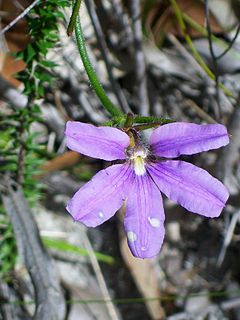
Scaevola ramosissima, commonly known as the purple fan-flower or snake flower is a flowering plant in the family Goodeniaceae and is endemic to south eastern Australia. It has wiry, horizontal branches and purple fan-shaped flowers.

Olearia asterotricha, commonly known as rough daisy-bush, is a species of flowering plant in the family Asteraceae. A tall shrub with white, mauve or blue daisy like flowers growing from the Blue Mountains in New South Wales to western Victoria, Australia.
Eremophila undulata, commonly known as wavy-leaved eremophila, is a flowering plant in the figwort family, Scrophulariaceae and is endemic to Western Australia. It is a small shrub with greenish-brown flowers and leaves that have a wavy margin.
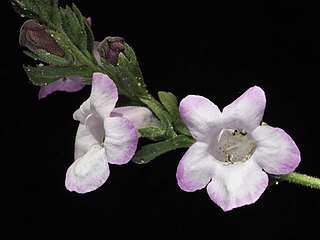
Dasymalla teckiana is a flowering plant in the mint family Lamiaceae and is endemic to Western Australia. It is a small, openly branched, sticky shrub with mauve and white, bugle-shaped flowers.

Pityrodia byrnesii is a flowering plant in the mint family Lamiaceae and is endemic to Arnhem Land in the Northern Territory. It is a shrub with hairy, glandular stems, stalkless, flat leaves and fragrant, off-white, bell-like flowers with purple stripes inside the tube.
Olearia adenolasia, commonly known as woolly-glandular daisy-bush, is a species of flowering plant in the family Asteraceae. It is a small upright shrub with sticky leaves and blue-purple or white daisy flowers.

Chloanthes coccinea is a species of flowering plant in the family Lamiaceae. It is a small, sprawling shrub with scarlet or deep pink flowers. It is endemic to Western Australia.
Scaevola collina, is a species of flowering plant in the family Goodeniaceae. It is a small sub-shrub with blue to purplish flowers. It grows in South Australia.

Scaevola depauperata, commonly known as skeleton fan-flower, is a species of flowering plant in the family Goodeniaceae. It is a small understorey shrub with blue, mauve or cream-white flowers. It grows in mainland states of Australia with the exception of Western Australia.
Olearia newbeyi is a species of flowering plant in the family Asteraceae and is endemic to the south-west of Western Australia. It is a shrub with broadly linear to narrowly oblong leaves, and dull purple, daisy-like inflorescences.
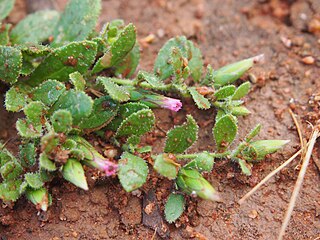
Streptoglossa cylindriceps is a species of flowering plant in the family Asteraceae and grows in Western Australia, South Australia and the Northern Territory. It is a ground cover or ascending perennial or annual herb with bluish purple or pink flowers.
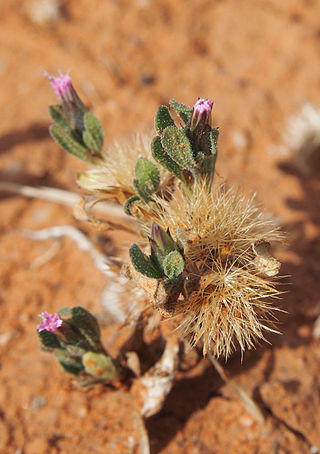
Streptoglossa adscendens, commonly known as desert daisy, is a species of flowering plant in the family Asteraceae and grows in all mainland states of Australia with the exception of Victoria. It is a ground cover, upright or ascending perennial or annual herb with purple or pink flowers.

Streptoglossa bubakii is a species of flowering plant in the family Asteraceae and grows in Queensland, Western Australia and the Northern Territory. It is an upright, aromatic perennial herb with pink, purplish-blue or red to brown flowers.
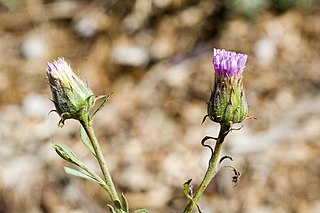
Streptoglossa liatroides is a species of flowering plant in the family Asteraceae. It is a low, spreading or upright perennial herb with pink or red to purple flowers. It grows in South Australia, New South Wales, Western Australia and the Northern Territory.
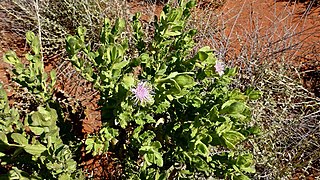
Streptoglossa macrocephala is a species of flowering plant in the family Asteraceae. It is a spreading or upright perennial herb with pink to purple flowers. It grows in Queensland, Western Australia and the Northern Territory.

Streptoglossa odora is a species of flowering plant in the family Asteraceae. It is a spreading, perennial herb with pink or bluish-purple flowers. It grows in Queensland, Western Australia and the Northern Territory.
Streptoglossa tenuiflora is a species of flowering plant in the family Asteraceae. It is an upright perennial or annual herb with pink to purple flowers. It is endemic to Western Australia.















